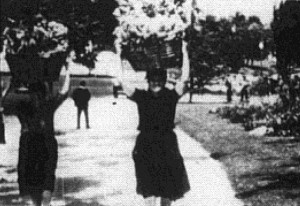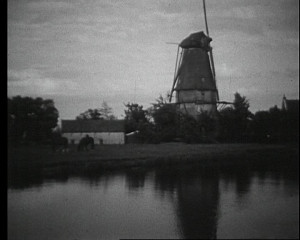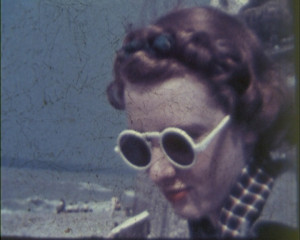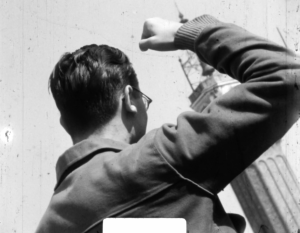"George Kiehl's visit to Paris took him to many of the places of interest in the visitor. His fast moving travelog takes us through the main streets and some of the old sophisticated areas. We begin with the landmark of the 1889 Exhibition, followed by fountains, facades, monuments of marble and bronze, parades, tired souls asleep on the street, art centers, castles, water excursions, and, not to forget, Moulin Rouge and other night spots with choice centers of attraction" PSA Journal, Nov. 1958, 48.
"In Peasants, Konstantin Kostich, ACL, has produced a sympathetic and withal entertaining picture of the people of village and farm land in Czechoslovakia and Roumania. Expert photography, an understanding choice of camera angle and workmanlike sequences mark this interesting film study and serve as a vehicle for its outstanding quality — a sincere and attractive presentation of the people as they are, not as they might be made to appear for the sake of motion picture cleverness. Mr. Kostich needs rely only on his own skill and can afford to neglect making a point of what, in dress or custom, might appear to be a strange peculiarity to another people. Unlike many professional travel photographers, he can avoid these obvious aids to sustain interest and can present his peasants on the friendly basis of real understanding. This does not mean that he does not tell a real story; it simply means that he tells it fairly and sincerely and, hence, beautifully." Movie Makers, Dec. 1934, 534.

"As indicated by the title, Miss Webb-Smith has built her picture around people; street scenes of people going about their business, children at play, girls with heavy loads on their heads, laundry activities along the river shore, also some views of the architecture, cork harvest and processing. She lets us feel that w have visited Portugal" PSA Journal, Oct. 1961, 49.
"The Island of Rhodes lies in the Agean Sea off the coast of Greece. Its barren, rocky terrain is home to the strong and hard working people, who have weathered the centuries with little change, in spite of the historical remnants of past invaders. They lead a hard, simple and religious life, but when an occasion arises, all join in the festivities of the celebration, roasting whole lambs over charcoal pits and preparing the delicacies for the general feast. The contrast is stark as a great modern ocean liner glides out of the ancient harbor that once was guarded by one of the Seven Wonders of the World - the Colossus of Rhodes" PSA Journal, Oct. 1963, 40.

"A four reel film recording details of a motor tour undertaken by Eustace and Eunice Alliott through six of the twelve Dutch provinces" (EAFA Database).
"Mr Alliott responded by projecting yet another film, in colour, recording a visit to Holland, in which there were some excellent shots of Dutch scenery, including the gorgeous tulip fields. There were also many happy portraits of peasants and children in their quaint national costume." (Anon, Photographic Journal, 418)
[Information included on the EAFA database suggests that the film was partially shot using prismatic film which, when using red, blue and green filters on a Kodak A projector, a colour experience is possible. This includes the scenes of: Volendam, Marken, Alkmaar (lively cheeses), Sneek, Veere, Domburg etc.]

"Amateur filmmaker, cinema historian and railway engineer H.A.V. Bulleid employs his flair for amateur production to spice up his home movies of a romantic trip to France. Acting in a moment of impulse, a man proposes to take his female friend to Paris. Leaving behind Dover's white cliffs, they arrive in Calais 'in less time than it takes to read the Bible'. Once their car - named 'Tilly' - has been unloaded, they set out to Paris via Le Tréport, Belleville, Rouen and Louviers. Arriving in the French capital they head straight to 'the film director's joy', the Avenue des Champs-Élysées and L'Arc de Triomphe, visit the Paris Bourse and tour the city's streets and boulevards. Pausing for a drink, they continue on to Place Saint-Augustin and Montmartre, dining at Moulin de la Galette - 'a tourist's paradise...pay double and eat half' - before catching a film at Studio 28. Tearing themselves away from the city of light with one last drink at Cafe George V, they drive through a gathering storm to Étaples and on to Le Touquet-Paris-Plage, 'haunt of motion picture stars', before a flurry of editing retraces their trip, marked out on a map" (EAFA Database).
"Item is a double feature production of a trip Dr. Willinsky took to Portugal and Morocco with his wife, Sadie. In the form of a travelogue, footage of landmarks, landscapes, vegetation, historic sites and the local population is interspersed with maps and captions that were added in by Dr. Willinsky to provide context. Featured cities include Lisbon, Tangier, Casablanca and Villa Daressada. Sadie is occassionally spotted sight-seeing, interacting with locals and purchasing wares from street vendors." Ontario Jewish Archives.
"Edited film of Greece by a Greek immigrant to the United States was specifically created to educate American audiences to the true qualities and nature of the Greek people. Footage includes Athens, Greek ruins, and country villages," via the Human Studies Film Archives, Smithsonian Museum.

Documentary about how a wealthy family from Barcelona spends the last year of the Spanish Civil War, from the Francoist point of view. The film includes very rare footage of everyday life during the war, as well as reenacted scenes shot after the end of the conflict, and the use of stop motion and archival materials.
"Item is a film taken by Dr. Willinsky of a trip to Italy. In the form of a travelogue, footage of landmarks, ruins and the local population is interspersed with captions that were added in by Dr. Willinsky to provide information about the country's history and culture. Although the title highlights the film's documentation of Rome and Naples, other Italian cities are featured as well; including, Pompeii, Florence and Venice. Dr. Willinsky's wife, Sadie, is occassionally spotted in the footage with travel companions who are probably relatives or family friends." Ontario Jewish Archives.
Total Pages: 15